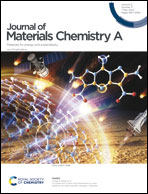Engineering ultrafine PtIr alloy nanoparticles into porous nanobowls via a reactive template-engaged assembly strategy for high-performance electrocatalytic hydrogen production†
Abstract
The delicate maneuver of geometric arrangement, overall nano-architecture and chemical component of noble metal-based electrocatalysts is greatly imperative for the advancement of various industrial technologies; however, it remains severely challenging. Herein, we demonstrate a functional amino-induced self-sacrificial templated strategy for the synthesis of hollow and porous platinum-iridium alloyed nanobowls (referred to as Pt7Ir NBs hereafter) with asymmetric open shells composed of ultrafine nanoparticles. Owing to the PtIr bimetallic alloy synergy, small size of primary building blocks, and highly open structure, the self-supported Pt7Ir NBs display a modulated electronic structure, 3D availability of exterior/interior surfaces, and high atom-utilization efficiency, which collectively make the resulting Pt7Ir NBs competent high-performance electrocatalyst. As a demonstration, when electro-catalyzing the hydrogen evolution reaction (HER), the standard Pt7Ir NBs with modicum Ir introduction deliver extraordinary electrocatalytic performance with an overpotential of 20 mV at 10 mA cm−2 and remarkable long-term robustness in a 0.5 M H2SO4 electrolyte, exhibiting enormous potential for electrochemical H2 production and various sustainable energy technologies. The innovative engineering of the nano-architecture of precious metal-based nanocrystals into well-defined porous and hollow structures via a feasible self-templated synthetic methodology may pave the way for the future development of a variety of high-efficiency electrocatalysts.

- This article is part of the themed collection: Journal of Materials Chemistry A HOT Papers


 Please wait while we load your content...
Please wait while we load your content...